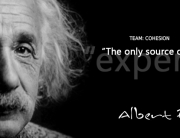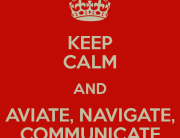Debriefing
Or: The art of gaining experience through the strategic review and debrief of past events
Every flight student has those painfully vivid memories of certain points in time during their training. They cringe when retelling the story of their first “wheelbarrow” landing, or smile proudly at the recollection of a rather well-executed full instrument approach. To me, that moment in time was not define by an event – but rather by a person.
Before I continue with the story, however, I must profess that I had some of the best, most knowledgeable and patient flight instructors a student could ask for. But I must also confess that I am not always the smartest, and to me “Practice makes perfect” is definitely a true telling of my performance. On one particular day, having jumped in the flight school’s twin engine PA31-Navajo, my instructor and I set out to, well, practice. The IFR training curriculum required many practiced holding patterns, course navigation and instrument approaches. Nevertheless, I was ecstatic! Having just transitioned form the single engine trainers to this powerful little twin engine, I felt like I was on top of the world.
Soaring into the sky with a resounding RRROOARR, the rhythmic beat of our two supercharged engines almost set the pace as we settled into the training routine. Intercept a course, Hold at a fix. Prepare for the approach. Having obtained the most recent weather from the airport automated reporting, the prognostic looked good: a solid overcast layer over the airport offered us a chance to practice real instrument flying while still giving us a safe margin for training. As we started our decent my heart began to beat a little faster. The excitement, coupled with the stress of the learning curve, where making me feel more alive than ever! Then suddenly…
“WHAT are you going?” the voice of my instructor snapped me out of my reverie. “What comes next? Always stay ahead of the airplane! You should be lowering the landing gear by now!” As he continued on my spirit sank to the ground. I WAS about to lower the landing gear, couldn’t he have given me one more second? As we went down the approach and completed the landing, the instructor’s voice continued to ring as he debriefed me on my performance at the same time as everything else was happening. Needless to say that my performance found itself as low as my spirits, as I could not bring myself to concentrate once more on the exercise at hand while my senses and wits were dulled by the continuing tirade of comments and “pointers”. Feeling emotionally and mentally drained, I let out a sigh of relief when the flight eventually came to an end.
Walking back to the instructor’s office, I replayed the events in my head. In truth, it had not been a very successful flight training-wise. Had I been given the chance to rectify the situation with a simple pointer or reminder, while debriefing the problems afterwards, I would have remembered much more from that flight than just my instructor’s voice in my headset. Instead.. well, there’s the story you just read. From then on, I vowed to myself to never jeopardize the safety or learning potential of a flight by trying to debrief a coworker (Captain, FO or even cabin crew) until the time was right and everybody had a chance to talk with a level head.
So this brings me to one of the final chapters of this study. Did you encounter a threat during the flight which you had to manage? Did a crew member make an error which could or did jeopardize the safety of the flight? Nevertheless, a timely and structured debriefing is crucial to gaining experience from the event and moving forward to a better performance and safety the next time. As I mentioned in the story, timely certainly does not mean while the event is occurring. So let’s talk about debriefing.
History and evolution
During WWII, US Army’s Chief Historian – Brigadier General Marshall – performed the first historical group debriefing. As soldiers recounted events of combat, feelings and how it impacted their decisions, some surprising and unexpected findings were made.
Some psychological benefits were found, bringing about a deeper interest into the matter. However, it wasn’t until the 80s that actual research was carried out more thoroughly. In 1983, a psychologist named Mitchell who worked with hospital emergency services personnel developed a method of debriefing called Critical Incident Stress Debriefing (CISD). There were of course attempts at debriefing before then, but their records were dubious and left a lot of questions as to their content and effectiveness.
A few years later, Dyregrov, the director of the Norwegian Center of Crisis Psychology, further modified Mitchell’s method to create a slightly more complex system. Finally, it wasn’t until the Golf War that Frank Parkinson, a US Army Chaplain, developed his own three-stage model after working with soldiers coming out of the war. Another slight variation of the original model, his “Three F” system has proved widely popular. (One last major model called “Emotional Decompression Model” was later created by a Police officer who actually suffered from PTSD to help victims of the same affliction, but this model does not relate to our study’s needs.)
Why is Debriefing important?
“Experience is something you don’t get until just after you need it.” – Steven Wright.
During the flurry of development and research on the subject in the 80s, Lederman coined a very important term: Cognitive Assimilation of Experience. In three words, he summarized the absolute necessity and reason of debriefing. Experience.
In order to gain knowledge and skills – experience – from past events, we have to be able to make sense of them. We have to learn new ways of seeing, perceiving, & making sense of experience. Debriefing gives us a powerful tool to structure the process. As individuals or a group, we can then pull out the crucial information that will allow us to learn from past experiences. Only through this process can we then reduce the error or threat factor, thus further enhancing the safety and effectiveness of future operations.
A Debriefing’s structure
There are necessary skills to a successful debrief. Mastering them is not easy and dedicated training is usually de rigueur. However, Debriefing is an important tool to understand and have. Any team leader or member should understand its basics steps, needs, and benefits.
So to better understand this, we need to analyze and understand the following key elements:
Communication
First and foremost, communication is key. Trust and respect between the crew are the catalysts to proper dialog. Understanding the variations of communications style and how we each express ourselves differently will allow a frustration-free debriefing, allowing the crew to instead concentrate on the issues being discussed. Remember, we are all Birds of a Feather (Chapter 3, TEAM Communication). But which bird are you? If you haven’t done so yet, I invite you to review the chapter explaining the four main types of communicators here.
Time matters
When to engage into debriefing is the reason that prompted this chapter in the first place. Although this is a controversial factor, the importance of timing cannot be stressed enough. When to select right time for discussion has been a big part of the research on Debriefing. Dyregrov emphasized on this skill during his research and divided it into two parts.
– Timing: The ability to know when to engage into debriefing is usually a factor of experience. Trial and error will be your best friends, but some basics remain. Avoid at all cost to start the process during the event. It will dramatically reduce the proficiency level and proportionally increase the risk for errors and problems while your crew is subjected to multiple cognitive processes at the same time. Make mental or written notes and if needed take corrective measures to ensure safe or efficient operations, but keep the debriefing for after.
Time proximity to the event will often be dictated by external factors: A long flight, different priorities upon mission completion, availability of crew, etc. Allowing time between the event and the debrief allows “hind-sight” to help clarify things before discussing them, but waiting too long can hinder the correct recollection of important details.
– Length: Once engaged in debriefing, make sure to moderate it to avoid unnecessary lengthy debates and keep it focused on the objectives or problems at hand. Silence can be a powerful tool as well, promoting self-questioning introspection. This in turn promotes more open and honest discussion.
Emotion
Events that require debriefing usually contain a certain element of stress. As we just discussed in the TEAM Cohesion chapter, stress is often synonym to emotions as part of the decision making cognitive process. This then leads to the understanding of “Emotional Intelligence” and the role it plays at the very core of each of us. Finally we land back at the very beginning of our journey, where we learned about TEAM Assessment. Every little part of this subject is intrinsically connected, as emotions, communications and experience play a symbiotic role in a successful and safe operation or mission.
Structure
As we discussed in the history and introduction to Debriefing, there are four major models – Mitchell/Dyregrov/Three-Stage/Emotional Decompression. All have been created based on psychological training and backgrounds, but their use vary depending on the context. The one I would suggest for use in a team/crew environment would probably be Parkinson’s “3 Fs”.
The Three-Stage (also known as the 3 Fs) Method: Provides structure for debriefing process with 3 segments in question format:
The Facts
- What was happening before the incident
- What happened during the incident
- What happened after the incident
The Feelings
- Sensory impressions (sight, sound, smell, touch, taste)
- Emotions – what feelings and emotions were generated?
- Reactions – How did you react then? How does that make you feel now? Anything positive?
The Future
- Normalization – Understand that to err is human, analyze the human factor in the event
- What can we learn going forward? Extrapolate into experience that can be shared and taught, or policies that can be implemented
- Provide support (personal, organizational, etc) if needed
Conclusion
Debriefing enables and enhances experience. It allows us to cognitively process information and learn from an event or a series of events. At the end of the day, the debriefing you carry out will be the turning point for your team: you will leave having gained knowledge and skill, or you will end with a bitter taste in your mouth. Those three tips will ensure you stay on the right track when releasing your team after a debrief:
Accentuate the positive. Underestimating the power of positive thinking will quickly undermine all your efforts to create an atmosphere of learning. Never leave your team hanging on a negative note after a debrief. It will be the only thing they remember. Many experiences can be perceived as negative especially in a high-stress and performance-based environment. It is, however, the responsibility of the leader to ensure that the team or individuals concludes the experience on a positive note to enhance the the value and quality of the lessons to be learned.
Higher Order Thinking: Lessons can be learned only if they can be understood. The saying “Hindsight is always 20/20′ offers great value in this setting. As you conclude your debrief, always keep the objectives of your team in sight: Safety, Performance, etc. Using those targets as a reference, use the details of your debrief to extract as much learning material as possible when bench-marked against them.
Experience Counts: Don’t stop there. The end of a briefing is only the beginning of a much broader process: teaching and training. Use all the resources available to propagate this new experience and allow other teams or individuals to learn from it while they train and prepare for their own work. This is the very heart of programs like SMS (Safety Management System), which airlines, hospitals and other skill-demanding or inherently dangerous/stressful environment need to implement or have implemented to ensure the successful and safe operation of their business.
Remember: Training+Performance=Safety. Training is acquired through the process of sharing knowledge. And, according to Albert Einstein: “The only true source of knowledge is Experience”. So Debrief, Learn, and Share!
______________________________________________
Bibliography & Research material:
The Art and Science of Debriefing -Maria Overstreet, PhD, RN, CCNS
A guide to psychological debriefing : managing emotional decompression and post-traumatic stress disorder – David Kinchin





























Nice article! This is certainly a valuable tool that I don’t think gets enough air play.
Kudos for the detailed write-up on the subject!
Brent
Thanks Brent! It’s something we all go through as pilots but understanding the psychology behind it could help any team tremendously I think especially when it’s not in a set learning environment!
A great post Jean! How do you feel about debrief through email? Do you think it possible for an instructor to email the debrief and have it accurate?
Hi Karlene! Thanks for the question! Email could be done, but here are my pros and cons about it:
Pros: It is known that communicating through a computer screen rather than face by face usually makes people more open and comfortable with sharing things openly. You may get more candid comments without the feeling of being directly judged by your peer.
Cons: You lose the advantage of time and so “proximity to event” becomes more challenging to achieve unless you have a specific protocol in place to record events and discuss them later.
But if that’s the only way available due to constraints or personal preferences, then I’d do it. Better than nothing!
[…] Post Flight -TEAM Review: The Secrets and Benefits of Debriefing -TEAM Success: Looking ahead to the next successful […]
[…] Lead your team (Leadership, Cohesion, Debriefing) […]